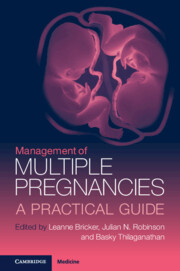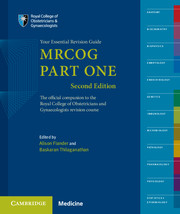44 results
Contributors
-
- Book:
- Management of Multiple Pregnancies
- Published online:
- 11 October 2022
- Print publication:
- 27 October 2022, pp viii-xii
-
- Chapter
- Export citation
Copyright page
-
- Book:
- Management of Multiple Pregnancies
- Published online:
- 11 October 2022
- Print publication:
- 27 October 2022, pp iv-iv
-
- Chapter
- Export citation
Contents
-
- Book:
- Management of Multiple Pregnancies
- Published online:
- 11 October 2022
- Print publication:
- 27 October 2022, pp v-vi
-
- Chapter
- Export citation
Editors
-
- Book:
- Management of Multiple Pregnancies
- Published online:
- 11 October 2022
- Print publication:
- 27 October 2022, pp vii-vii
-
- Chapter
- Export citation
Index
-
- Book:
- Management of Multiple Pregnancies
- Published online:
- 11 October 2022
- Print publication:
- 27 October 2022, pp 351-364
-
- Chapter
- Export citation
Plate Section (PDF Only)
-
- Book:
- Management of Multiple Pregnancies
- Published online:
- 11 October 2022
- Print publication:
- 27 October 2022, pp 365-376
-
- Chapter
- Export citation

Management of Multiple Pregnancies
- A Practical Guide
-
- Published online:
- 11 October 2022
- Print publication:
- 27 October 2022
Chapter 1 - Maternal Hemodynamics in Health and Disease: A Paradigm Shift in the Causation of Placental Syndromes
- from Section 1 - Physiology of Normal Pregnancy
-
-
- Book:
- Maternal Hemodynamics
- Published online:
- 28 April 2018
- Print publication:
- 03 May 2018, pp 1-12
-
- Chapter
- Export citation
13 - Statistics and epidemiology
-
- Book:
- MRCOG Part One
- Published online:
- 27 January 2017
- Print publication:
- 13 October 2016, pp 463-508
-
- Chapter
- Export citation
2 - Anatomy
-
- Book:
- MRCOG Part One
- Published online:
- 27 January 2017
- Print publication:
- 13 October 2016, pp 5-50
-
- Chapter
- Export citation
5 - Embryology
-
- Book:
- MRCOG Part One
- Published online:
- 27 January 2017
- Print publication:
- 13 October 2016, pp 149-200
-
- Chapter
- Export citation
Contents
- from 5 - Embryology
-
- Book:
- MRCOG Part One
- Published online:
- 27 January 2017
- Print publication:
- 13 October 2016, pp 149-150
-
- Chapter
- Export citation
1 - Introduction
-
- Book:
- MRCOG Part One
- Published online:
- 27 January 2017
- Print publication:
- 13 October 2016, pp 1-4
-
- Chapter
- Export citation
Contents
- from 9 - Microbiology
-
- Book:
- MRCOG Part One
- Published online:
- 27 January 2017
- Print publication:
- 13 October 2016, pp 315-316
-
- Chapter
- Export citation
Contents
- from 8 - Immunology
-
- Book:
- MRCOG Part One
- Published online:
- 27 January 2017
- Print publication:
- 13 October 2016, pp 291-292
-
- Chapter
- Export citation

MRCOG Part One
- Your Essential Revision Guide
-
- Published online:
- 27 January 2017
- Print publication:
- 13 October 2016
Contents
-
- Book:
- MRCOG Part One
- Published online:
- 27 January 2017
- Print publication:
- 13 October 2016, pp v-viii
-
- Chapter
- Export citation
Contents
- from 11 - Pharmacology
-
- Book:
- MRCOG Part One
- Published online:
- 27 January 2017
- Print publication:
- 13 October 2016, pp 391-392
-
- Chapter
- Export citation
Contents
- from 1 - Introduction
-
- Book:
- MRCOG Part One
- Published online:
- 27 January 2017
- Print publication:
- 13 October 2016, pp 1-2
-
- Chapter
- Export citation
12 - Physiology
-
- Book:
- MRCOG Part One
- Published online:
- 27 January 2017
- Print publication:
- 13 October 2016, pp 423-462
-
- Chapter
- Export citation



